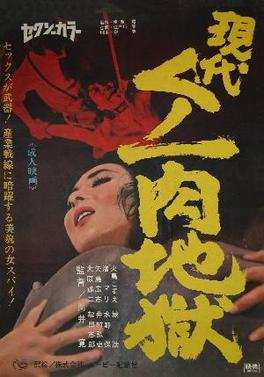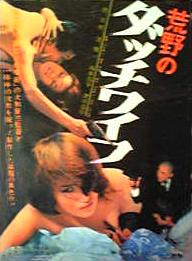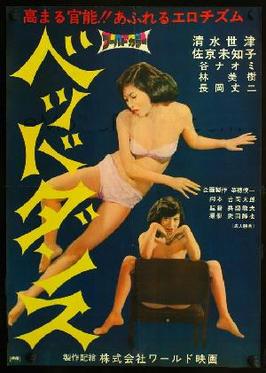Related Research Articles

In Japan, Pink film refers to movies produced by independent studios that includes nudity or deals with sexual content. This encompasses everything from dramas to action thrillers and exploitation film features. Many pink films would be analogous to erotic thrillers, e.g. Fatal Attraction, Fifty Shades of Grey, Basic Instinct, 9½ Weeks.

Kōji Wakamatsu was a Japanese film director who directed such pinku eiga films as Ecstasy of the Angels and Go, Go, Second Time Virgin. He also produced Nagisa Ōshima's controversial film In the Realm of the Senses (1976). He has been called "the most important director to emerge in the pink film genre," and one of "Japan's leading directors of the 1960s."
Naomi Tani is a Japanese pink film actress who is best known for her appearances in Nikkatsu's Roman Porno films with an S&M theme during the 1970s.
Masaru Konuma was a Japanese film director known for his Roman Porno films for Nikkatsu during the 1970s.

Yasuharu Hasebe was a Japanese film director best known for his movies in the "Violent pink" subgenre of the Pink film, such as Assault! Jack the Ripper (1976), Rape! (1976), Rape! 13th Hour (1977) and Raping! (1978). Earlier genre films directed by Hasebe include Black Tight Killers (1966) and the Alleycat Rock series (1970).
Giichi Nishihara, also known as Shirō Sekiya, was a Japanese film director, screenwriter, producer and actor best known for his low-budget and sensationalistic pink films made for his Aoi Eiga studios in the 1960s and 1970s. He has been called both "Japan's sleaziest movie-maker," and "a cult favorite among devotees of extreme cinema."
Chūsei Sone was a Japanese film director known for his stylish and popular Roman Porno films for Nikkatsu, particularly the first two installments of the Angel Guts series. Despite a somewhat uneven career, many mainstream critics consider Sone the best of Nikkatsu's Roman Porno directors.
Noriko Tatsumi is a Japanese actress known primarily for her appearances in pink films of the 1960s. During the "First Wave" of pink film, Tatsumi became known as the first "Queen" of Japanese softcore sex movies, a title which she held from 1967 through 1970. She most often appeared in the films of the World Eiga and Nihon Cinema studios, and is best known for her work with director Kōji Seki, especially Whore (1967) and Erotic Culture Shock (1969). She also appeared in director and Seijun Suzuki script-writer, Atsushi Yamatoya's influential 1967 cult film, Inflatable Sex Doll of the Wastelands.

Satoru Kobayashi was a Japanese film director most famous for directing the first pink film, the type of softcore pornographic films that became the most prolific film genre in Japan during the 1960s and 1970s. Japanese sources claim that Kobayashi directed over 400 pink films between 1960 and 1990, making him possibly the most prolific Japanese film director.
Mamoru Watanabe was a Japanese film director, screenwriter and actor, known for his work in the pink film genre. Along with directors Genji Nakamura and Banmei Takahashi, Watanabe was known as one of the "Three Pillars of Pink".

Kan Mukai a.k.a. Hiroshi Mukai and Patrick Kan was a Japanese film director, cinematographer, producer and screenwriter, known for his pioneering work in the pink film genre. In the realm of pink cinema, Japanese critics have estimated that Mukai is "the only serious rival of Kōji Wakamatsu." As a producer, Mukai helped the early careers of many prominent directors, including Hisayasu Satō and Academy-Award winner Yōjirō Takita. In his career, he directed nearly 200 films and produced approximately 500.

Apartment Wife: Affair in the Afternoon a.k.a. From 3 to Sex is a 1971 Japanese film in Nikkatsu's Roman Porno series. The first film in this successful new direction for the studio, it was directed by Shōgorō Nishimura and starred Kazuko Shirakawa.

Naked SevenakaSengoku Rock: Female WarriorsandWarring States Rock: Gale-Force Women is a 1972 Japanese film in Nikkatsu's Roman porno series, directed by Yasuharu Hasebe and starring Mari Tanaka.

Banmei Takahashi is a Japanese film director. Takahashi started his career in the pink film industry, making his directorial debut in 1972 with Escaped Rapist Criminal. Due to a disagreement with his producer, Takahashi quit the film industry for a couple years. He joined pink film pioneer Kōji Wakamatsu's production studio in 1975, working as a script-writer until Wakamatsu produced Takahashi's second film, Delinquent File: Juvenile Prostitution (1976). For the next few years Takahashi averaged five films annually at Wakamatsu's studio, until Takahashi left to start his own production company in 1979.

Modern Female Ninja: Flesh HellakaInferno of the Flesh is a 1968 Japanese pink film directed by Kan Mukai. It is in the part-color format which was used in pink films in the late 1960s and early 1970s before full-color was made standard with the introduction of Nikkatsu's Roman porno series.

Inflatable Sex Doll of the WastelandsakaDutch Wife of the WastelandandThe Dutch Wives of the Wild, originally released as Horror Doll, is a 1967 Japanese pink film written and directed by cult filmmaker Atsushi Yamatoya, starring the first "Queen" of pink film, Noriko Tatsumi, and with music by the noted jazz pianist, Yōsuke Yamashita.

Bed Dance (ベッドダンス) is a 1967 Japanese pink film directed by Toshio Okuwaki for World Eiga. One of the director's most praised films, it features an early appearance by Naomi Tani.
Million Film (ミリオンフィルム) was one of the early independent studios which produced pink films. Along with OP Eiga, Shintōhō Eiga, Kantō and Kōji Wakamatsu's production studio, Million Film was one of the most influential on the genre during its first decade. Many of the most prominent directors and performers in the pink film genre worked for Million Film.
OP Eiga (オーピー映画), also known as Ōkura Eiga (大蔵映画) or Okura Pictures, is the largest and one of the oldest independent Japanese studios which produce and distribute pink films. It was founded in 1961 by Mitsuru Ōkura, former president of film studio Shintōhō. Along with Shintōhō Eiga, Kantō, Million Film, and Kōji Wakamatsu's production studio, Ōkura was one of the most influential studios on the pink film genre. Among the many notable pink films released by the studio are Satoru Kobayashi's Flesh Market (1962), the first film in the pink film genre.
Flesh Market is a 1962 Japanese film directed by Satoru Kobayashi and starring Tamaki Katori. It is generally recognized as the first movie in the pink film genre.
References
- ↑ "さよなら、香取環" (in Japanese).
- ↑ Weisser, Thomas; Yuko Mihara Weisser (1998). Japanese Cinema Encyclopedia: The Sex Films. Miami: Vital Books : Asian Cult Cinema Publications. pp. 20, 22, 317. ISBN 1-889288-52-7.
- 1 2 3 4 5 6 7 8 Connell, Ryann (March 2, 2006). "Japan's former Pink Princess trades raunchy scenes for rural canteen". Mainichi Shimbun . Retrieved 2007-11-12.[ dead link ]
- 1 2 Sharp, Jasper (2008). Behind the Pink Curtain: The Complete History of Japanese Sex Cinema. Guildford: FAB Press. p. 60. ISBN 978-1-903254-54-7.
- ↑ Weisser, p.21.
- ↑ Domenig, Roland (2002). "Vital flesh: the mysterious world of Pink Eiga". Archived from the original on 2004-11-18. Retrieved 2007-02-19.
- ↑ Macias, Patrick (2001). "Pink and Violent". TokyoScope: The Japanese Cult Film Companion. San Francisco: Cadence Books. p. 174. ISBN 1-56931-681-3.
According to some counts, from 1965 to 1973 pink movies amounted to as much as half of Japan's total domestic film product.
- ↑ Weisser, p.287.
- ↑ Sato, Tadao (1987) [1982]. Currents in Japanese Cinema. Translated by Barrett, Gregory (paperback ed.). Tokyo: Kodansha. p. 244. ISBN 0-87011-815-3.
- ↑ Weisser, p.351.
- ↑ Firsching, Robert. "Midareta Kankei". Allmovie. Archived from the original on 2006-04-26. Retrieved 2007-03-09.
- ↑ Sharp, 182.
- ↑ Firsching, Robert. "Nikutai No Yuwaku". Allmovie. Retrieved 2007-03-09.
- ↑ Sharp, p. 107.
- ↑ Weisser, p.289.
- 1 2 "YIDFF News" (in Japanese). Yamagata International Documentary Film Festival . Retrieved 2010-03-28.
奥脇敏夫監督...ピンク映画第1号女優香取環と結婚した男
- ↑ "60年代・独立プロ伝説 西原儀一と香取環 前編 (1960s Independent Films: Giichi Nishihara & Tamaki Katori retrospective)" (in Japanese). Kobe Planet Film Archive. 2009-09-12. Archived from the original on 2011-07-23. Retrieved 2009-12-02.
- ↑ Filmography based on: "TAMAKI KATORI". The Complete Index to World Film. Retrieved 2007-03-06.
Tamaki Katori at IMDb
"香取環 (Tamaki Katori)" (in Japanese). Japanese Movie Database . Retrieved 2007-03-06.and
Weisser. - ↑ "Okinawa kaidan: Sakaduri yuurei / China kaidan: Shikan yaburi". Japanese Horror Movies Database. Archived from the original on January 13, 2007. Retrieved 2007-03-09.
- ↑ プレイガール (in Japanese). tisen.jp. 2007-03-15. Retrieved 2008-01-30.